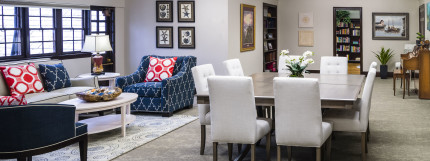As a homeowner, decorating your home and turning it into a space of your own is one of the most fulfilling projects. The process allows you to inject your personality into a space and create something unique! For instance, you may have an idea to incorporate drapes into your window scheme, or perhaps you want to change the color on your walls to match a new couch. While these ideas seem like a great idea in your head, on paper their cost can quickly add up.
Unfortunately, there is no magic formula to figuring out how much an interior design project will total up to, but there are ways you can make estimates on your project, and a few tips on where to spend your money and where to save!
- Create a Budget: Knowing what you have to spend and dividing it up into categories will help you avoid overspending in the long run. After some basic research, you’ll be able to estimate how much you think a project will cost, and then figure out how much you are willing to spend in total. Consider the rooms you want to decorate, their sizes, and how much work each room will need. Then, you can take your budget and divide it up accordingly.
- Where to Splurge: Once you have your budget, you’ll want to spend the majority of it on great furniture pieces. As a professional, I always recommend making seating a priority when redesigning a room. Whether it’s a recliner or a dining room table, quality helps slow the wearing process and will lessen your chances of having to purchase new items every few years. A durable piece of seating can last for a long time, and might only need to be reupholstered to bring it back to life. With that in mind, save a good portion of your budget to invest in a couch, chairs, and mattresses. These items get the most use in your home, and therefore wear the quickest. When it comes to accessories, you always want to spend more on window treatments. This simple accessory can transform the look of a room.
- Where to Save: Thankfully, there are certain interior design items you can save on without cheapening the look of a space. You can really get away with spending less on accessories like lighting, wall color, area rugs, picture frames and vases. Accessorizing a room shouldn’t take up much of your budget, and in most cases, you can even find better quality items at thrift stores or flea markets. For instance, you might find a shelving unit that can be re-stained to match your decor at half the price of a new one.
Ideally, you should spend the most money on rooms that you spend the most time in, and on furnishings that you spend the most time utilizing. For more help with creating an interior design budget and spending the right amount on the right things, contact Gina Wolleat, a Blaine, MN interior decorator, today.




